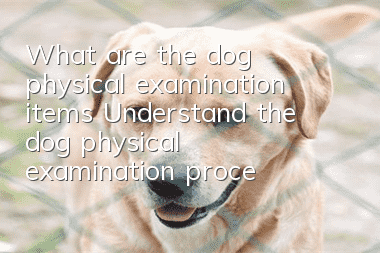What are the dog physical examination items? Understand the dog physical examination process

Dog physical examination: basic physical examination
Basic physical examination is a basic examination that must be done when every dog comes to the hospital. The purpose is to allow veterinarians to judge from the dog’s appearance and physical symptoms. Dog health. Basic physical examination is an important method for detecting lesions, including a total of 8 items:
1. Check the condition of various organs on the head
Mainly observe whether there are any abnormal colors and secretions in the dog’s ears, eyes and nasal cavity. In addition, dental health is also an important inspection object.
2. Check the sound of breathing
A dog's normal breathing is almost silent under normal circumstances, and detailed auscultation can only be performed with a stethoscope. If you hear your dog making unusual breathing noises, seek medical attention immediately.
3. Check for abnormal redness, swelling, dandruff and secretions on the skin
If the dog’s skin has abnormalities, such as odor and hair loss, seek medical attention immediately.
4. Check if there are any abnormalities in the anus and urinary organs
If the dog’s anal glands are blocked, a strong odor will be emitted, and the dog will also scratch.5. Check bones and muscles
Check whether the joint movements of the whole body are normal and whether the skeleton is healthy. Press the entire spine to find out whether there are potential spinal diseases.
6. Check the chest and abdominal cavity
The doctor uses his fingers to tap the dog's chest and abdominal cavity to determine whether there is fluid accumulation in the lungs and whether there is flatulence to determine the dog's health. Through detailed palpation of the abdomen, we can know whether the size and relative position of the organs are correct, and whether there are abnormal hard lumps and lumps.
7. Check whether there are any lumps all over the body
Touch the dog's whole body and feel for any abnormal lumps on the body surface. Lymph nodes throughout the body can be palpated, and organ parts should also be lightly palpated. For irritating coughs, it is necessary to check whether there are abnormalities in the trachea.
8. Observe the dog’s actions
Finally, observe whether there are any abnormalities in the dog’s standing and sitting actions.
Dog physical examination: blood test
Blood test is one of the health checks after the basic physical examination. Blood tests can determine whether an animal is anemic, has inflammation, how many platelets it has, whether it has blood diseases, whether it has blood parasites, etc. Blood tests can be divided into the following six categories:
1. Number of red and white blood cells
Understand the number and proportion of various cells in the blood.
2. Blood smear
Because the machine itself has errors in calculating various types of white blood cells, blood smears are used to perform classified examinations of white blood cells. In addition, blood smears can also be used to check the morphology of cells and whether there are blood parasites.
3. Enzyme test
Understand the preliminary physiological status of each organ.
4. Ion test
Check the concentration of sodium, potassium, chloride, calcium, magnesium and phosphorus in the blood.
5. Blood gases
Understand the pH and distribution of gases in the blood.
6. Special testing
Can detect whether dogs have heartworm, Lyme disease and other infectious diseases.
- Can dental cleaning sticks replace brushing? You don’t want to be dizzy when a dog licks your face?
- How to change dog food for dogs? How to transition dog food to dogs
- What are the benefits of feeding dogs dog food? Pet experts analyze the benefits of feeding dog food
- Diseases that Teddy is prone to: Scientific feeding will prevent you from getting sick
- What's going on if the dog doesn't eat?
- How to feed your dog properly and choose the best dog food according to the season
- Is it necessary to remove dog’s wolf toes? I’ll let you know the secrets of dog’s paws
- Diet precautions for puppies: Never touch these deadly foods
- What should you pay attention to after tooth extraction for dogs? Take good care of your dog’s health
- How to raise a Bichon Frize The complete guide to raising a Bichon Frize



